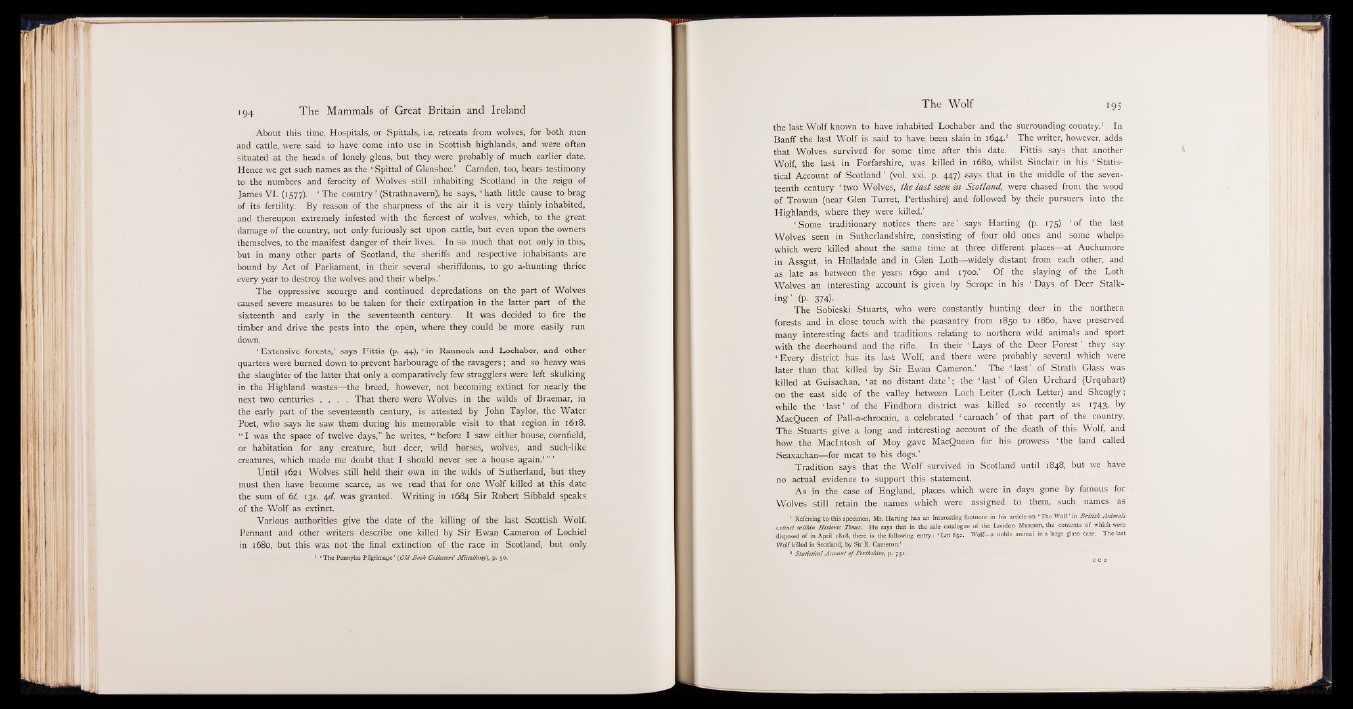
About this time, Hospitals, or Spittals, i.e. retreats from wolves, for both men
and cattle, were said to have come into use in Scottish highlands, and were often
situated at the heads of lonely glens, but they were probably of much earlier date.
Hence we get such names as the ‘ Spittal of Glenshee.’ Camden, too, bears testimony
to the numbers and ferocity of Wolves still inhabiting Scotland in the reign of
James VI. (1577). ‘ The country’ (Strathnavern), he says, ‘ hath little cause to brag
of its fertility. By reason of the sharpness of the air it is very thinly inhabited,
and thereupon extremely infested with the fiercest of wolves, which, to the great
damage of the country, not only furiously set upon cattle, but even upon the owners
themselves, to the manifest danger of their lives. In so much that not only in this,
but in many other parts of Scotland, the sheriffs and respective inhabitants are
bound by Act of Parliament, in their several sheriffdoms, to go a-hunting thrice
every year to destroy the wolves and their whelps.’
The oppressive scourge and continued depredations on the part of Wolves
caused severe measures to be taken for their extirpation in the latter part of the
sixteenth and early in the seventeenth century. It was decided to fire the
timber and drive the pests into the open, where they could be more easily run
down.
‘ Extensive forests,’ says Fittis (p. 44), ‘ in Rannoch and Lochaber, and other
quarters were burned down to prevent harbourage of the ravagers; and so heavy was
the slaughter of the latter that only a comparatively few stragglers were left skulking
in the Highland wastes— the breed, however, not becoming extinct for nearly the
next two centuries . . . . That there were Wolves in the wilds of Braemar, in
the early part of the seventeenth century, is attested by John Taylor, the Water
Poet, who says he saw them during his memorable visit to that region in 1618.
" I was the space of twelve days,” he writes, “ before I saw either house, cornfield,
or habitation for any creature, but deer, wild - horses, wolves, and such-like
creatures, which made me doubt that I should never see a house again.1” ’
Until 1621 Wolves still held their own in the wilds of Sutherland, but they
must then have become scarce, as we read that for one Wolf killed at this date
the sum of 6/. 135. \d. was granted. Writing in 1684 Sir Robert Sibbald speaks
of the Wolf as extinct.
Various authorities give the date of the killing of the last Scottish Wolf.
Pennant and other writers describe one killed by Sir Ewan Cameron of Lochiel
in 1680, but this was not the final extinction of the race in Scotland, but only
1 ‘ The Pennyles Pilgrimage ’ {Old Book Collectors' Miscellany), p. 50.
the last Wolf known to have inhabited Lochaber and the surrounding country.1 In
Banff the last Wolf is said to have been slain in 1644.2 The writer, however, adds
that Wolves survived for some time after this date. Fittis says that another
Wolf, the last in Forfarshire, was killed in 1680, whilst Sinclair in his ‘ Statistical
Account of Scotland ’ (vol. xxi. p. 447) says that in the middle of the seventeenth
century ‘ two Wolves, the last seen in Scotland’ were chased from the wood
of Trowan (near Glen Turret, Perthshire) and followed by their pursuers into the
Highlands, where they were killed.’
‘ Some traditionary notices there are’ says Harting (p. 175) ‘ of the last
Wolves seen in Sutherlandshire, consisting of four old ones and some whelps
which were killed about the same time at three different places— at Auchumore
in Assgut, in Halladale and in Glen Loth—widely distant from each other, and
as late as between the years 1690 and 1700.’ Of the slaying of the Loth
Wolves an interesting account is given by Scrope in his ‘ Days of Deer Stalkin
g ’ (p. 37 4 )-
The Sobieski Stuarts, who were constantly hunting deer in the northern
forests and in close touch with the peasantry from 1850 to i860, have preserved
many interesting facts and traditions relating to northern wild animals and sport
with the deerhound and the rifle. In their ‘ Lays of the Deer Forest’, they say
‘ Every district has its last Wolf, and there were probably several which were
later than that killed by Sir Ewan Cameron.’ The ‘ last’ of Strath Glass was
killed at Guisachan, ‘ at no distant date’ ; the ‘ last’ of Glen Urchard (Urquhart)
on the east side of the valley between Loch Leiter (Loch Letter) and Shengly;
while the ‘ last’ of the Findhorn district was killed so recently as 1743, by
MacQueen of Pall-a-chrocain, a celebrated ‘ carnach ’ of that part of the country.
The Stuarts give a long and interesting account of the death of this Wolf, and
how the Macintosh of Moy gave MacQueen for his prowess ‘ the land called
Seaxachan— for meat to his dogs.’
Tradition says that the Wolf survived in Scotland until 1848, but we have
no actual evidence to support this statement.
As in the case of England, places which were in days gone by famous for
Wolves still retain the names which were assigned to them, such names as
' Referring to this specimen, Mr. Harting has an interesting footnote in his article on ‘The Wolf’ in British Animals
extinct within Historic Times. He says that in the sale catalogue of the London Museum, the contents of which were
disposed of in April 1818, there is the following entry: ‘ Lot 832. Wolf—a noble animal in a large glass case. The last
Wolf killed in Scotland, by Sir E. Cameron.’
2 Statistical Account of Perthshire, p. 731.